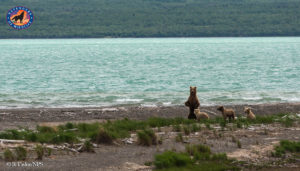President Trump’s National Park Service Proposes to Abandon Federal Wildlife Management on Alaska’s Preserves
On May 22, the Trump administration proposed removing existing National Park Service (NPS) hunting regulations on national preserves in Alaska and defer instead to whatever the state’s hunting regulations may be for these federal lands and waters. The stated reason for the change is to better align the federal and state regulations and to provide hunting opportunities for sportspeople. But the effect of it would be to allow hunting methods like baiting bears, shooting cubs and sows with cubs, and shooting bears and cubs and wolves and pups in dens — on 25 million acres of land where these activities aren’t supposed to occur.

This is remarkable because, in just a few sentences, this administration’s misguided proposal would reverse an extensive rulemaking process completed less than three years ago that unequivocally found that hunting methods like these are incompatible with the purposes for which Alaska’s national preserves were created in the first place. It is remarkable in its assumption that simply aligning preserve regulations with state hunting rules, or providing additional hunting opportunities, could comprise sufficient justification for such an abrupt policy reversal. And it goes without saying that the hunting methods that could be allowed are antithetical to any sense of “fair chase” and thus anathema to any ethical hunter, let alone the vast majority who don’t hunt but do appreciate wildlife. And, finally, the proposed regulatory rollback amounts to a complete abdication of responsibility for managing preserves according to NPS’s mission.
National preserves are essentially national parks except that hunting is allowed. Under the Alaska National Interest Lands Conservation Act (ANILCA), the blueprint for federal land management in the state, NPS is supposed to manage preserves “for the benefit, use, education and inspiration of present and future generations,” and to preserve “natural undisturbed, unaltered ecosystems while allowing for recreational opportunities, including sport hunting.”
Specifically regarding wildlife harvest, the standard to be met in regulating the taking of fish and wildlife and trapping, is that the preeminent natural values of the park System shall be protected in perpetuity and shall not be jeopardized by human uses. ANILCA also retained the NPS Organic Act and implementing policies, which require NPS to protect natural ecosystems and processes, including the natural abundances, diversities, distributions, populations, habitats, genetics, and behaviors of wildlife.

Finally, and most directly relevant to the regulation currently proposed, NPS policy states that “activities to reduce . . . native species for the purpose of increasing numbers of harvested species (i.e. predator control)” are not allowed on lands managed by the NPS.
In contrast to this highly protective NPS mission to balance hunting with conservation of natural diversity on preserve lands, the state of Alaska manages wildlife on the “sustained yield” principle that, pursuant to its 1994 Intensive Management law, specifically includes reducing predators in an attempt to boost prey populations like moose and caribou. Thus, there is a fundamental difference between the federal and state management goals for preserve lands, a difference that expresses itself in hunting regulations and the types of practices allowed.

Until now, NPS has always rejected state efforts to specifically reduce predator populations on preserve lands. But now, contrary to preserve purposes and NPS regulations, the Park Service wants to relinquish its responsibility to manage wildlife for natural diversity. If the state wants to turn Alaska’s national preserves into game farms, where predators are managed to scarcity and their ecological role on the landscape is diminished, and visitors will have a harder time finding wolves and bears , then that’s now acceptable to the Trump administration.
But eliminating current protections for wildlife and wildlands is not okay with us.
You can help us fight this injustice by speaking up here:
https://secure.defenders.org/site/Advocacy?cmd=display&page=UserAction&id=3338










Follow Defenders of Wildlife
facebook bluesky twitter instagram youtube tiktok threads linkedin